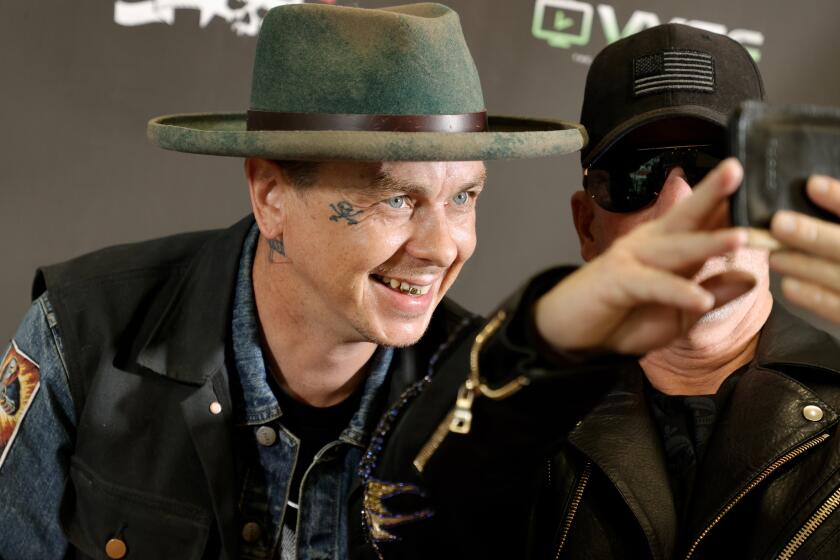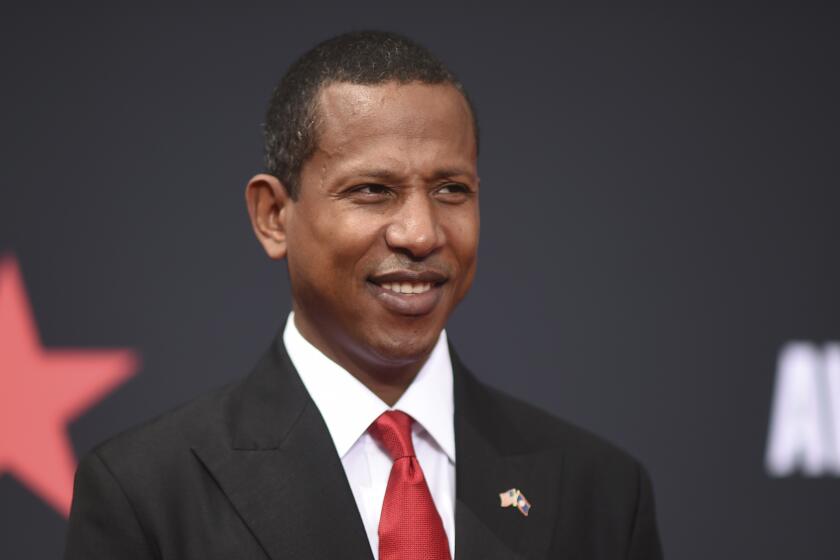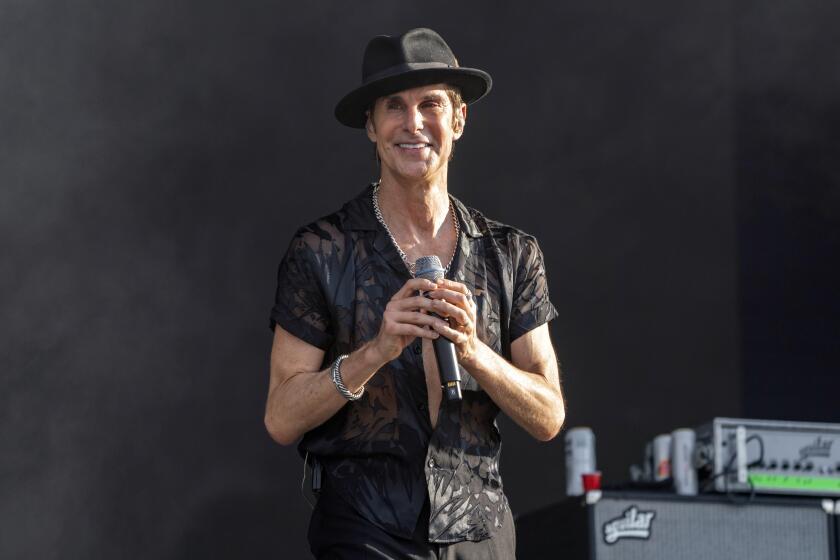Still With the Band
“I didn’t feel old in years; my soul just felt old because of all we had gone through,” Robbie Robertson says as he watches a DVD of “The Last Waltz,” Martin Scorsese’s superb documentary of the Band’s farewell concert a quarter-century ago at Winterland in San Francisco.
“We wanted to keep recording but quit the grind of the road, which was wearing us down. The plan was for everyone to take time off for some personal projects and then come back refreshed. I didn’t realize we were all going to fly off and that no one would remember where the nest was or how to fly back.”
It’s late afternoon in Robertson’s office at DreamWorks Records in Beverly Hills, and it sounds like a tinge of sadness in his voice as he looks back at the demise of the Band.
But maybe I’m just projecting. The rock world has certainly missed the Band.
On nights when the group was in “the zone” on stage, as Robertson would say, it was hard not to feel this was the best rock ‘n’ roll band in the world--the Beatles, Rolling Stones or you-name-it notwithstanding.
In guitarist Robertson, bassist-singer Rick Danko, drummer-singer Levon Helm, pianist-singer Richard Manuel and keyboard whiz Garth Hudson, the Band was blessed with five master musicians, three superb singers and a storehouse of songs (mostly by Robertson) about family, community and tradition that were so finely crafted they felt as if they had been carefully handed down for generations.
The blend of country, blues, gospel and folk seemed as pure as rich Delta soil. The Band’s first two albums--1968’s “Music From Big Pink” and 1969’s “The Band”--are classics of American pop culture.
Robertson isn’t big on looking back, but he is proud of the Band’s legacy and the way it was captured in “The Last Waltz.” That’s why he spent six months upgrading the sound for various “Last Waltz” projects, including film’s current re-release and the DVD, which is due in stores May 7. The DVD includes two commentary tracks and other features. The boxed set, from Warner Bros./Rhino, supplements the 30 tracks from the original soundtrack album with 24 other performances from the concert and rehearsals.
In the restored film, which will be shown on VH1 on May 11, the Band is joined by some of the most respected musical figures of the era, including Bob Dylan, Neil Young, Joni Mitchell, Van Morrison and Eric Clapton. Scorsese focuses closely on the interaction between the musicians, offering an intimacy and power that have been rarely captured on film. Above all, it’s an eloquent toast to the glories of American rock ‘n’ roll, especially those ‘60s musicians who turned the raw energy of the rock pioneers into an art form.
“I remember sitting around back then with Joni [Mitchell], Bob [Dylan] and Neil [Young] and we would talk about Hank Williams and Billie Holiday the way people now talk about the people on stage with us in San Francisco--and I wanted the film to be as presentable as possible,” Robertson says, as on the TV monitor the Band goes into the playful “Up on Cripple Creek,” one of its most popular numbers.
“I wanted the sound and picture to be as [sharp] as possible so younger generations could see where some of the sounds they hear today came from. I didn’t want people to look at it and say it’s kind of faded now, it’s not up to par with what we are used to hearing these days.”
Robertson’s office in DreamWorks’ single-story brick building next door to the Beverly Hills post office is a combination of rock history and state-of-the-art music workshop.
Two walls are lined with vintage guitars, including an acoustic model dating to the early 1900s and an electric instrument with dual guitar/mandolin necks that Robertson played on “The Weight” during the “Last Waltz” concert.
But most of the space is devoted to the present, including stacks of discs of works in progress at the label and sophisticated keyboard equipment that enables him to sketch out musical ideas. He’s a quietly confident man and a natural storyteller who has been in on some of rock’s historic moments and shares them with an enticing sense of detail. At 58, he still has the rugged good looks that made Hollywood race after him with acting offers following “The Last Waltz.” He did star in 1980’s “Carny” but has mostly devoted his time to music.
DreamWorks co-founder David Geffen and label executive Mo Ostin created a position for Robertson in 1998 with a rare mandate that includes artistic and executive responsibilities. Ostin, then at Warner Bros., helped finance the filming of “The Last Waltz.”
“The whole thing started so informally,” Robertson recalls over the sound of the Band from the TV. “We were just going to do a show with a couple of friends, but then it grew and someone thought it’d be a good idea to document it. The original plan was just to have a couple of people walk around with video cameras, but as time went on we realized we might ought to think about something a little more substantial.”
It was soon obvious they needed a real filmmaker, and luck was on the Band’s side in landing someone of Scorsese’s skills.
Scorsese, who grew up on ‘50s rock ‘n’ roll and edited the “Woodstock” documentary film, wanted to direct his own rock film, and he saw “The Last Waltz” as a cultural event. Before the shooting, he sat down with the Band and came up with a thick script that gave specific camera angles for every lyric and chord change in the songs.
Although Winterland was just another drab rock ballroom, the staging made it look like a European opera house. The musicians played against a backdrop of “La Traviata” borrowed from the San Francisco Opera. Huge chandeliers hung from the ceiling.
“That was Boris Leven’s idea,” Robertson says suddenly, eyeing the chandeliers and referring to the production designer, whose credits ranged from “Giant” to “West Side Story.”
“He came to us one day and said he had gotten these chandeliers from ‘Gone With the Wind’ and thought they would look fabulous, but I go, ‘Chandeliers? I don’t think that’s going to go over with Neil or Bob or the rest of the musicians. These people don’t do chandeliers, Boris.’”
Ronnie Hawkins, the first of the guests to join the Band on stage during the concert, brought the five musicians together in Toronto around 1960. The Arkansas native was a minor rockabilly figure in the U.S., but he found a large, enthusiastic audience in Toronto for his supercharged live show. Drummer Helm had come from Arkansas with Hawkins, but the other members of the Band were Canadian.
As Hawkins and the Band go through an energetic version of the old Bo Diddley hit “Who Do You Love?” on the TV, it’s easy to picture what it must have been like in the early ‘60s when they barnstormed the South, playing honky-tonks and college halls.
Robertson joined Hawkins’ band, the Hawks, when he was in his mid-teens, so he forsook a lot of schooling, which is surprising considering that he is one of rock’s most articulate and culturally minded figures.
“I was so excited to be in that world that I didn’t think much about schooling until we played all these universities when I was 18, 19,” Robertson says, when asked about the point. “I didn’t necessarily want to trade places with them, but I was interested in how they were feeding their mind. So I used to read everything I could get my hands on--to the point it really annoyed Ronnie Hawkins. He was a street guy. He thought all that intellectual stuff was just poisoning your mind.”
Robertson chuckles at the thought.
It’s not until later in the film that Dylan, the other dominant influence in the Band’s career, pops up. The crowd’s response was joyous, but Robertson recalls the era’s hostility from Dylan’s old folk crowd, who felt betrayed when the Band added blistering rock ‘n’ roll to his old acoustic, folk approach.
“We didn’t realize when we went to work with Bob that they were going to boo us and throw stuff at us all over the world,” Robertson says. “After we did that [1966] tour, people were telling Bob, ‘You’ve got to get rid of these guys. They are ruining your career.’ But Bob didn’t budge.”
The follow-up tour was scrapped, however, after Dylan had a motorcycle accident in 1966. The Band moved to the Woodstock area in upstate New York, where Dylan was living, and they would gather most days to work on material in the basement of the house that became known as Big Pink.
“I remember typewriters on tables upstairs in the living room and Bob would write like 30 verses, then take a guitar or piano and figure out the melody,” Robertson says. “Then, someone else would be typing something and when the page was full, we would go downstairs and experiment. It was a wonderful time because it was just for us. Little did we know it would become this big bootleg thing.”
“The Basement Tapes,” as the music from those days became known, was the most celebrated bootleg of the rock era. The music, a marvelous blend of American roots styles, was so fresh that many critics named it the best album of the year when it was formally released by Columbia Records in 1975.
That spirit carried over into the Band’s own recordings. “Music From Big Pink” even included songs from “The Basement Tapes.” The more formal “The Band” was the group’s creative peak. From “Across the Great Divide” through “The Night They Drove Old Dixie Down,” the songs represented a clearer and more conscious vision--a salute to the American history and culture that inspired and fascinated Robertson.
“The reaction to ‘Music From Big Pink’ gave everybody a confidence to just knock down all the boundaries,” Robertson says.
The thing that strikes you most while watching the Band, Dylan and the other “Last Waltz” musicians perform “I Shall Be Released” at the end of the film is how young everyone looks. That’s not the way they seemed at the concert itself.
I was in the audience at Winterland, and there was the sense that the group had come to the end of the road--and that others on stage, including Dylan and Clapton, who were all in their 30s, may have been nearing the end too.
Robertson still looks robust enough to be on stage. It’s hard to imagine that he doesn’t feel some regret that the Band couldn’t have kept it together--but again I’m projecting.
Robertson isn’t interested in playing “what if?,” partially because the Band’s post-”Last Waltz” history has its share of darkness. The group--minus Robertson--hit the road again in 1983, but the shows had little impact. Manuel, who long battled alcoholism, hanged himself in a Florida motel bathroom in 1986. Danko, who also had substance abuse problems at various points in his career, died in his sleep at his home near Woodstock in 1999.
In his 1993 autobiography, “This Wheel’s on Fire,” Helm complained that Robertson tried to control the group and eventually forced it to break up. Robertson declines to reflect on his relationship with the Band members, other than to praise them for their musical gifts.
Some observers paint “The Last Waltz” as the end of an era, a time when artistic impulses were more valued than the novelty flash that surrounds so many hit acts today. You can feel the Band’s influence on lots of critical favorites, including just about everyone who’s played on the Americana radio format. But the mainstream pop airwaves have little connection to the music of the Band or the other stars who stroll through “The Last Waltz.”
“The big difference to me is these people in this movie and at that time were like the voice of that generation,” he says when asked about the difference between the music scenes then and now. “The music wasn’t just background. It played a pivotal part in everyday life. They wore these records out. Today, the music [on the radio] isn’t the voice of a generation. It’s entertainment. It’s hard to find complete artists. I find it to be more to be individual cuts than full albums.
“But that doesn’t mean there aren’t things worth finding and supporting now. A lot of my friends think everything today is [worthless], but I don’t. I really appreciate a lot of it, and I’m enjoying this process at DreamWorks, working with a bunch of young artists I want to help groom.”
*
Robert Hilburn, The Times’ pop music critic, can be reached at robert.hilburn@latimes.com.
More to Read
The biggest entertainment stories
Get our big stories about Hollywood, film, television, music, arts, culture and more right in your inbox as soon as they publish.
You may occasionally receive promotional content from the Los Angeles Times.










